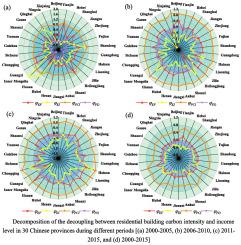当前位置:
X-MOL 学术
›
Environ. Impact Assess. Rev.
›
论文详情
Our official English website, www.x-mol.net, welcomes your
feedback! (Note: you will need to create a separate account there.)
Decoupling and decomposition analysis of residential building carbon emissions from residential income: Evidence from the provincial level in China
Environmental Impact Assessment Review ( IF 9.8 ) Pub Date : 2021-01-01 , DOI: 10.1016/j.eiar.2020.106487 Tengfei Huo , Yuling Ma , Tao Yu , Weiguang Cai , Bingsheng Liu , Hong Ren
Environmental Impact Assessment Review ( IF 9.8 ) Pub Date : 2021-01-01 , DOI: 10.1016/j.eiar.2020.106487 Tengfei Huo , Yuling Ma , Tao Yu , Weiguang Cai , Bingsheng Liu , Hong Ren

|
Abstract Decoupling residential building carbon emissions from residential income has great significance for carbon mitigation and even global climate change. However, the nature of the decoupling relationship between them is still unclear. This study adopts the Tapio decoupling model to explore the decoupling relationship among residential building carbon emissions (TC), per capita carbon emissions (PC), residential carbon intensity (FC) and per capita income (PCI) across 30 Chinese provinces from 2000 to 2015. Then, the Logarithmic Mean Divisa Index (LMDI) model is used to decompose the decoupling of residential building carbon intensity and PCI at the provincial level to determine the main factors determining this relationship. Results show that the main decoupling trend between FC and PCI in 30 provinces transformed from weak decoupling state to strong decoupling state during the whole period, while there is still extensive room for TC and PC to decouple with PCI. PCI has the major inhibiting effect on the decoupling between FC and PCI, while residential energy intensity (EI) has the primarily promoting effect on the decoupling. These findings provide valuable references for international policymakers in formulating precisely targeted energy-saving and carbon-reducing policies to coordinate the relationship between income and carbon emissions, and the results also can be applied to other economies and, to a greater extent, other pollutants.
更新日期:2021-01-01











































 京公网安备 11010802027423号
京公网安备 11010802027423号